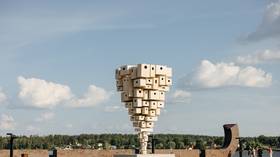From ore to art: How a tiny factory town became the capital of Russian street art


Vyksa is a tiny single-industry town, located in the south-west of Nizhny Novgorod region, some 360 km from Moscow. Its livelihood is a gigantic metallurgical plant, employing a quarter of its 58,000 population. But steel, ore, fire, and smelters coexist side-by side with more than a hundred of street art pieces, numerous murals, and sculptures scattered across the place, transforming it into an open-air art hub.
The art pieces were all created over the past 12 years, the main catalyst being the Vyksa Festival (ex Art-Ovrag festival). And it is not just a middle-of-the-road art festival, but an annual celebration of modern Russian culture, the first of its kind in the country, with the whole town participating.
Vyksa is an example of a successful urban planning story in a so-called monocity. It escaped the grim fate met by many post-Soviet factory towns, of which there are more than 300, from the westernmost province of Kaliningrad to the Far East.

A monocity or monotown is a settlement built around a factory of one industry, in order to keep it running continuously. Some, like Vyksa, appeared in the Russian Empire, with the majority materializing under the planned economy of the Soviet Union.
The post-Soviet reality of privatization proved disastrous for many monocities. Among the problems were the outflow of young people, infrastructure problems, and low activity of the population.

But Vyksa persevered, and managed to find its way, transforming itself through modern art and urban culture.
This year’s edition was held for two weekends at the end of June, packing dozens of events in the field of visual, musical, theatrical, architectural and even gastronomical performance. The entire programme was created by Vyksa residents in collaboration with famous artists, musicians, actors, directors. The organizers reported more than 35 thousand visitors.

“Such projects expand, and put Vyksa on the map of cultural events in the country. Not so long ago, no one had even heard what kind of town it was, and now anyone who is interested in art and culture should know Vyksa”, Ekaterina Bochavar, this year’s festival curator and Moscow gallery director, told journalists.
Every couple of years the festival has a different art curator from the top of the Russian cultural scene. It is the synthesis of street culture and community engagement that helps form the dynamic cultural landscape of the town. All art is out on the streets, and it is Vyksa-specific.

As an interactive part of the festival, locals put on roles of guides in a sort of field-trip-performance. During one dubbed ‘To the homes’, tourists were invited as guests to visit Vyksa residents' houses, to try homemade dishes and listen to life stories. Others involved urban exploration of art and parks, and there was also the chance to see how the steel factory works.
“Contemporary art is not an object, contemporary art is a language, it is an opportunity to communicate with each other”, Bochavar noted, adding that “the city changes incredibly from year to year and people change”.

Behind the town’s transformation is the OMK factory (United Metallurgical Company), which operates six plants, occupying a third of the entire area of the town. Vyksa Steel Works forges pipes used in Nord Stream, and its smelters heat ore that turns into wheels for high-speed trains. About 15,000 people work at the plant. It operates non-stop, round the clock, all year round.

The goal was to invest in its workers and in a comfortable urban environment by establishing the ‘OMK-Uchastie’ (Participation) foundation. It started with social projects, before expanding into the Vyksa festival and more.
“For more than 10 years, from the idea of a small festival, we came to large-scale projects in culture, urban planning and the social sphere”, Irina Sedykh, chair of the foundation said in an interview with the Vyksa festival newspaper.

The foundation also created the unique Industrial Street Art Park on the premises of the factory. The idea is that each year, different street artists from Russia will put a mural on one of the walls of the plant.
In 2017, one of the first graffiti artists in the country, Misha Most, painted the world's largest mural created by a single artist, according to the organizers at creative studio Artmossphere.

And in 2020 the foundation commissioned what became Erik Bulatov’s biggest work. The Soviet-born artist is one of the founders of the so-called Sots Art movement, the Soviet answer to Andy Warhol’s Pop Art, “Sots” being a contraction of socialism and art.
“Vyksa beckons and attracts. Today, hundreds of bright and creative people from all over Russia come here. They go for new emotions, inspiration, ideas and communication”, Sedykh said, adding that “all this helps locals look at the city in a new light, get enchanted with it and fall in love again”.
